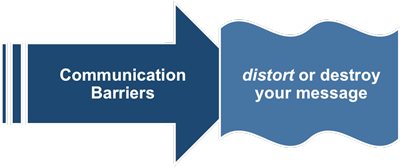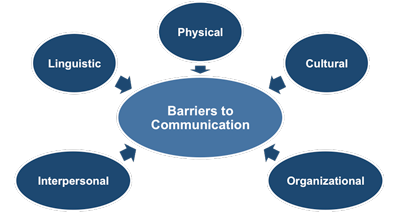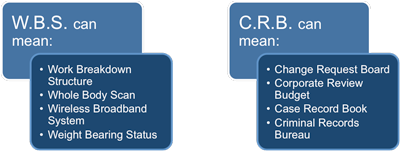Effective Communication in the Workplace - Barriers to Communication
Problems with communication occur when the way in which we express ourselves is not fully understood and appreciated by those we want to communicate with. Some of these differences are within our control, others are not, and being forewarned about such obstacles influences how successful your communications will be.
 |
Communication often takes place in a complex and uncertain environment; understanding how to minimize such difficulties will have a direct impact on how effective our communications are. Those who are seen as good communicators have the ability to adapt their communication style to overcome barriers to understanding and to maximize the impact of their message.
There are numerous barriers to communication that can be classified as:
 |
Organizational
Every organization you come into contact with in your role has its own ethos and set of acceptable behaviors. To be a successful communicator you need to understand the beliefs and values of your own organization.
You will be able to identify in your senior management the sort of behavior that is deemed appropriate for the organization. You will also have the opportunity through the example you portray to influence the behavior and beliefs of those who report to you or interact with you.
These behaviors will determine the type of environment your organizational communications occur in. Is it one of openness and trust, or is it one of guardedness and blame? Whatever atmosphere your day-to-day activities occur in, you will need to adapt your style and signals to best suit the environment.
Often within organizations confusion and obstacles to communication result from poor definition of individual roles within the structure and of their working relationships and interactions. How many times have you found several people believing that a task is the responsibility of someone else? Rather than take the trouble to ensure someone accepts ownership, some people will simply sweep the task under the carpet on the assumption that someone else will perform it! This does not bode well for success.
Many organizations' communication problems can be directly attributed to poor operational skills. This can be caused by a lack of procedures that help define and structure communications. Or it can be the result of little or no understanding of other operations within the organization or its external suppliers.
Without this level of appreciation and comprehension unrealistic demands can be placed on others. This confusion and misinterpretation can be avoided be taking the time to learn about other departments and external bodies and listen to what they say in response to your communication.
Organizational barriers can also occur if you use an inappropriate communication tool to send your message. Is the sending of an email or text an appropriate way to inform someone of a major disruption to service that will have serious financial implications if not addressed immediately? No, it is not. A personal call or going to the office of the senior executive will portray the correct level of urgency and importance for such a message.
Selecting the best communication tool to send your message is an essential component of excellent communication skills. Much of this comes from experience and observing how senior management and personnel in external organizations communicate their messages.
In some instances you may want to use more than one tool. For example, in the situation above you may want to speak to the person face-to-face first and then confirm that conversation in an email, copying in only those who need to be kept abreast of the situation.
Physical
This relates to the physical attributes of the environment the communication takes place in. This means such things as the layout of the room and access to privacy.
Many individuals operate in open plan offices, which whilst offering easy access to other members of the team when working within a group, can make other tasks more time consuming than necessary. Developing ideas or strategies, for instance, may require a quieter, more private environment, with few or no interruptions.
Organizations generally conduct a wide variety of tasks, and management need to provide environments to suit different tasks if their workforce are to operate and communicate effectively. For example, providing access to private rooms as well as open plan offices, and being willing to allow people to work from home, offers a choice of environment to best suit the task at hand.
Cultural
Organizations, with their global markets and operations, need to be conscious of what they say and of the interpretations different nationals working for them may give to their messages. This is especially significant if your message needs to be translated into other languages.
For example, Spanish is much more formal when communicating in writing than it is verbally. Conversational Spanish is more colloquial and direct, supported by appropriate gestures and eye contact. So when you are making organizational communications you need to have a native speaker translate your message to make sure that it communicates what you want it to mean.
When thinking about cultural differences it is important not to pay too much attention to stereotypes. A stereotype is 'a widely held but fixed and oversimplified image or idea of a particular type of person or thing.' However, some stereotypes do have their roots in observable behavior. For example, many people from the British Isles use understatement in their everyday speech and would describe something as 'not bad' when in fact they thought it was good or even very good. This type of cultural difference can confuse people who speak the same language but who are not used to hearing understatement used in this way.
Cultures also have different interpretations of what is meant by something being 'urgent' and what level of work is considered stressful. This may result from different working hours in certain countries, and the fact that operations are taking place in different time zones. So when you are communicating your message you will need to take these into account.
Your message needs to clearly state your definition of terms such as 'afternoon,' and you should make sure the date you require the task to be completed by is accurate for the time zone of the recipient. For example, Friday 20th actually occurs on different days if you are based in London and the recipient is in Hong Kong.
Linguistic
With the increase in specialist language and jargon within the workplace, ensuring that what you are saying is interpreted as you want and expect is an essential aspect of communication.
 |
This is especially important when communicating with a wide variety of industries because each one may have their own expressions and acronyms for terms, as shown in the diagram above.
In your communications you should never assume your meaning is the same for all those you are interacting with. You need to actively listen to and observe your audience to ensure that your message is received in the way you intend.
Interpersonal
Some barriers to communication result from the interpersonal skills of the individuals involved. Each person's level of self-esteem and their degree of confidence will be portrayed to others by the communication signals they display. It will also be reflected in the attitude they adopt during the exchange.
An aggressive attitude that may be intended by the communicator to display confidence may be interpreted as arrogance. Their nonverbal signals may be seen as an attempt to hide their lack of knowledge. The aggressive attitude might also be a way of showing how stressed they are in their current role and that any further demands on that person's time is just too much for them to cope with.
To be an effective communicator you must also be conscious of your own bias, which can influence how you respond in an exchange. This may not be an informed bias: it may be based merely on your own experiences or knowledge base. If you don't open your mind to listen carefully to what is being said and objectively assess what you hear your bias will persist and could become a barrier to the communication process.
Developing your own questioning, analytical, and listening skills is essential if you want to communicate successfully and will have a direct impact on your career development.
You may also be interested in:
Effective Communication in the Workplace | Workplace Communication Styles | Recognizing Workplace Communication Styles | Perceptual Preferences | Attitudes to Communications | Communication Research | Using the RESULT Principle.



